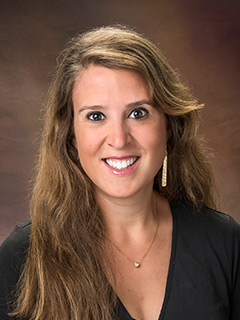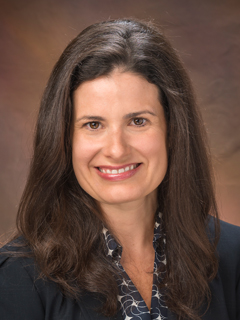HOW CAN WE HELP YOU? Call 1-800-TRY-CHOP
In This Section
Autism and COVID, Telemedicine, Hemoglobin, Williams Syndrome, AYAs

We've come a long way since the beginning of the COVID-19 pandemic, and this week's roundup of research highlights includes a host of findings related to re-assessing and re-building from its effects. Read about research on autism spectrum disorder (ASD) screening disparities during the pandemic, how to improve telemedicine and its efficacy as video visits remain a new normal, and the development of an assessment scale to measure COVID's impact on adolescents and young adults in healthcare settings.

Kate E. Wallis, MD, MPH
Autism Screening Disparities Persist in Pandemic's First Year
CHOP researchers have previously observed disparities in the number of children screened for ASD from certain sociodemographic groups. But in a new paper published in Academic Pediatrics, lead author Kate E. Wallis, MD, MPH, and her colleagues report that while ASD screening (and the well visits they often occur at) declined across all groups studied during the pandemic, a sharper decline was observed in families who receive public insurance, Black, and non-Hispanic White children. The study compared almost 25,000 patients between 16 and 26 months old who came in for a well visit between March 1, 2020, and February 28, 2021, (pandemic cohort) to approximately 26,000 patients who came in between March 1, 2019, and February 29, 2020 (pre-pandemic cohort).
The findings highlight the need to develop strategies, such as text message reminders with a link to an online screening questionnaire, to help children catch up with screening during this time.
"While we maintained a high level of screening during this challenging time, we suspected some children could have been missed," said Dr. Wallis, who is a developmental behavioral pediatrician in the Division of Developmental and Behavioral Pediatrics. "With multiple studies stressing the importance of early intervention, we want to make sure that any children who were missed still complete these vital screenings."
Telemedicine Effective for Patients With Genetic Disease
Though guidelines and restrictions for social distancing have relaxed, telemedicine continues to be an important option for patients seeking care. The use of telemedicine to evaluate patients with rare genetic conditions resulted in a similar rate of proper diagnosis as in-person visits, according to new research published in Pediatrics. However, the findings also suggest there is room for improvement, as collecting genetic material from patients who are seen remotely is more challenging, and families who report historically marginalized backgrounds have lower rates of telemedicine use.
The research addresses an access challenge in the field of rare genetic disease, in that while patients with rare genetic conditions must undergo physical examinations, diagnostic testing, patient counseling, and management, there is a shortage of providers who treat such conditions; those who do are concentrated in large urban academic medical centers. Since the COVID-19 pandemic provided a natural way to study telemedicine's efficacy, the researchers conducted a retrospective cohort study of 5,854 outpatient visits that took place before and after the pandemic restricted in-person visits.
"As a practicing geneticist, I have long emphasized the importance of a detailed physical examination to inform the diagnosis of my patients," said Ian M. Campbell, MD, PhD, attending physician in the Department of Biomedical and Health Informatics at CHOP and a senior author of the study. "However, our results challenge the assumption that such exams must occur in person."

Gerd A. Blobel, MD, PhD
Researchers Identify Novel Factors in Silencing Fetal Hemoglobin
CHOP researchers report their discovery of two novel factors in silencing fetal hemoglobin, a function that may prove effective for patients with sickle cell disease and beta-thalamessia, conditions that are caused by errors in the genes for hemoglobin. Most individuals make the switch from fetal hemoglobin, which is produced by the gamma-globin gene in utero, to adult hemoglobin, which is produced by the beta-globin gene after birth. In other words, the former gene is turned off, and the latter turned on. But patients with sickle cell disease and beta-thalassemia have mutations in the beta-globin gene, which leads to mutant hemoglobin production and serious health complications such as delayed growth, chronic pain, and stroke.
To identify which transcription factors are involved in silencing fetal hemoglobin and promoting adult hemoglobin production, CHOP researchers performed a genetic screen using CRISPR-Cas9 and identified two factors, NFIA and NFIX, that work together to repress fetal hemoglobin genes. Both are found elevated in adult red blood cells compared to fetal blood cells and in animal models.
"Our study shows that transcription factors NFIA and NFIX have dual activity, both turning genes on and turning others off, the combined effect of which is the silencing of fetal hemoglobin," said senior study author Gerd A. Blobel, MD, PhD, investigator in the Division of Hematology. "This research demonstrates how deeply complex the transition from fetal to adult hemoglobin is, but by better understanding the factors involved, future research could focus on exploiting these transcription factors as therapeutic targets."
The new research appeared in Nature Genetics.

Lisa Schwartz, PhD
Researchers Validate COVID-19 Exposure and Family Impact Scales to Measure Pandemic's Impact on AYAs
Having a validated measure of how adolescents and young adults (AYAs) are impacted by the COVID-19 pandemic is critical to providing optimal clinical care. To address this need, a team of CHOP researchers led by Lisa Schwartz, PhD, psychologist in the Division of Oncology, adapted an existing assessment for caregivers in healthcare settings, the COVID-19 Exposure and Family Impact Scales (CEFIS), to assess AYAs' exposure to and impact of COVID-19 via self-report. The researchers described in a recently published Pediatric Psychology paper, the development of the COVID-19 Exposure and Family Impact Scales (CEFIS-AYA), evaluated the structure of its scales, and explored differences in scores as a function of gender and age, with a goal of providing a basis for the measure's use in research and clinical care.
All in all, the team concluded that the CEFIS-AYA has strong initial reliability data. Their sample included 3,912 adolescents and young adults, ages 15 through 29, who completed the CEFIS-AYA and reported on two main categories: exposure and impact. There are seven factors for exposure (severe COVID-19, loss of income, limited access to essentials, COVID-19 exposure, disruptions to activities, disruptions to living donditions, and designation as an essential worker), and five for impact (self and family relationships, physical well-being, emotional well-being, social well-being, and distress).
CHOP and Penn Collaborate in New Center for Williams Syndrome Research and Care
Through the establishment of a new center, the Armellino Center of Excellence for Williams Syndrome at Penn, Penn and CHOP experts in Williams syndrome are bridging the gap between pediatric and adult care to advance scientific discovery and provide patients with the rare condition a model for coordinated care across the lifespan. The new center is fueled by a $25 million gift from Penn alumnus Michael R. Armellino.
Caused by deletions on chromosome 7q1, children with Williams syndrome generally exhibit unusual social abilities while also navigating intellectual disability, anxiety, executive function challenges, a predisposition for cardiovascular and metabolic disease, and other medical conditions.
CHOP is home to one of the largest Williams syndrome clinics in the country, and the establishment of the new center will be overseen by Daniel Rader, MD, chief of the Division of Human Genetics at CHOP. Dr. Rader also serves as chair of the Department of Genetics and Chief of the Division of Translational Medicine and Human Genetics at the Perelman School of Medicine at the University of Pennsylvania.
"Combining our passion for excellent care and discovery with the enthusiastic Williams syndrome community will lead to more support, advocacy and — hopefully — more answers than ever before," stated Dr. Rader in a press release.
"CHOP and Penn Medicine have a long history of collaboration to provide a continuum of care for patients with rare conditions like Williams syndrome," said Joseph W. St. Geme, MD, Physician-in-Chief at CHOP. "Our multispecialty Williams syndrome clinic has provided critical services for many pediatric patients, and this new center will allow us to meet all of their care needs as they transition from childhood through adulthood."
ICYMI
Catch up on our headlines from our May 27 In the News:
- PhD Nurse Serves in Two Influential Policy-making Leadership Roles
- Allogeneic CART for Relapsed or Refractory T-ALL Developed Using Base Editing
- CHOP and Penn Partner With Costa Rica for CAR T-Cell Therapy Research, Treatment
- CPR Education in High Schools is Proving Beneficial
- Can Genetics, Environment Contribute to Psychiatric and Cognitive Outcomes?
Keep up with our news, stories, and updates in real time by following us on Twitter, Facebook, LinkedIn, or Instagram. Or subscribe to our newsletter to get an email sent every other Friday by signing up here.



